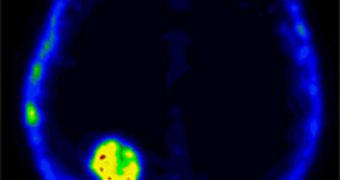At this point, the most invasive and aggressive forms of cancer, those affecting the lungs and the brain, are treated via a set of therapies, each of them constructed to address the issue at hand in a certain way. But there is the chance that a certain approach, though the best option according to standard practice, will not work on a patient. Doctors then have to renounce that specific therapy, and try out another. However, detecting whether a treatment method is effective can take up to two months, and that is, unfortunately, more time than many people have. But all that could change soon.
The Israel-based company Aposense announces the development of a new type of imaging marker. When used in combination with Positron Emission Tomography (PET) scans, the chemical is able to evidence dying cells. This is extremely important, because doctors could then determine whether sufficient cellular death takes place at the site of a lung or brain tumor to label the current therapy they are using as efficient. Having this kind of ability, of changing treatments faster than two months, say after only two-three weeks, could significantly increase the patients' chances of survival, especially when they are dealing with forms of cancer that usually kill within five to six months, Technology Review reports.
The company draws its name from apoptosis, which is an automated, natural process that occurs when cells inside living organisms commit “suicide.” In several types of cancer, this mechanism no longer functions, and this is what allows those specific cells to further replicate, transmitting their unhealthy mutations to other generations. Many kinds of tumors are made up of precisely this kind of cells, which have exceeded their life span considerably. There are a number of measurable factors that show if apoptosis is taking place or not, including changes in the target cell's electrical potential, the order and structure of lipids on its membrane, and the pH level inside.
“We have designed small molecules with very high specificity for the apoptotic cell. When this small molecule recognizes the set of alterations in the apoptotic membrane, it binds to the cell, goes through the membrane, and accumulates,” Ilan Ziv, who is the chief scientist at the company, explains. This remarkable achievement allows doctors to assess whether chemotherapy and radio therapy are working just a few days after the original treatment starts. The chemical is first administered to patients in its inactive state, and the stuff only activates when encountering the acidic environment around apoptotic cells.

 14 DAY TRIAL //
14 DAY TRIAL //